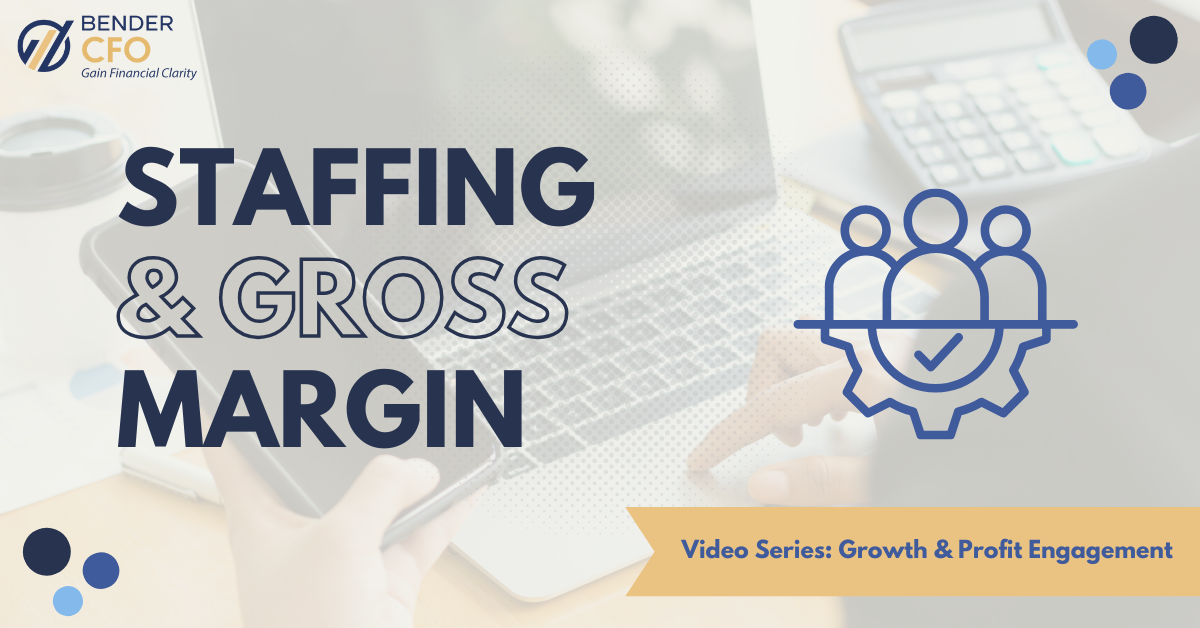The First Step to Agency Growth: Forecasting Existing Revenue
When you run a marketing agency or service-based business, you're constantly making big decisions....
By: Shane Bender on Oct 21, 2025 1:00:00 AM

Revenue is the headline everyone chases. But in service businesses like agencies, revenue only becomes profit when staffing is right. People are both your biggest cost and your biggest driver of delivery. Hire too early and your margins sink. Hire too late and capacity, quality, and growth all take a hit.
That’s why staffing has to be managed side by side with gross margin. In this blog (and in the Growth & Profit Engagement video series), I’ll show you how to use gross margin and revenue-per-person to guide smarter staffing and hiring decisions. We’ll use a marketing agency example, building on earlier videos that covered existing revenue and new business opportunities.
One of the lessons I learned from a former supervisor is this: be ambitious in your sales goals, but cautious in your expense planning.
Suppose you set a goal of 50% revenue growth. You build an expense plan around it, start hiring, and invest in new tools or travel. But if revenue only grows 20–30% (still a strong year!), your staffing costs will already be baked in. The result: Margins collapse and you could lose money despite growth.
Staffing must be based on realistic revenue expectations, not just aggressive sales targets.
In a service business, every dollar of revenue is tied to the people delivering the work. Staff fall into two groups:
Both groups are essential, but for gross margin, it's the delivery staff that is key. You need a direct line between the revenue you're generating and the number of people delivering the service for your clients.
Both are essential, but gross margin focuses on delivery staff. There should be a direct line between the revenue you’re generating and the people actually delivering that work. In other words: Revenue tells you the size of the workload, but staffing determines whether that revenue translates into profit.
There are two staffing metrics every agency or service firm should track monthly:
Take your monthly net revenue and divide it by the number of delivery staff. If it’s too low, you’re likely overstaffed. Too high, and burnout is on the horizon.
Formula: (Net revenue – Cost of Services) / Net revenue.
A target of 60% or higher is safe and typically very profitable, 50–60% is generally acceptable depending on overhead, and anything below 50% often signals trouble for profitability.
Together, these numbers ground your staffing plans in financial reality.
In our Growth & Profit Engagement work, we model revenue scenarios alongside staffing plans. For example, one agency planned to hire three new account managers in anticipation of sales growth. That decision made margins dip short-term, but ensured the team was ready when new clients arrived.
The key is making sure your margins are strong enough to absorb those dips. That means factoring in the full cost of people, not just salaries:
Only when you include these can you see your true gross margin and decide if revenue supports new hires.
If your gross margin slips under 50%, it’s time to dig deeper. The reasons usually fall into three buckets:
This is where client-level profitability analysis matters. Break out margins by client, often a few clients carry the business while others erode margins. Some new clients may be unprofitable short-term, but long-term drags need reevaluation. If staffing is tied up on accounts that never generate profit, revenue won’t convert to profit.
As a CFO and financial consultant for many small businesses, I strongly recommend that once you understand your revenue, you understand the staffing and build out the gross margin. With proper planning, good pricing, and good margins, you can get ahead of the game.
Ready to Strengthen Your Business?
Bender CFO Services’ Growth & Profit Engagement gives you clarity on revenue, expenses, staffing, and cash flow — all backed by advanced valuation tools. It’s a structured, short-term engagement designed to uncover growth opportunities, improve profitability, and help you plan for the future with confidence. Learn more about the Growth & Profit Engagement
When you run a marketing agency or service-based business, you're constantly making big decisions....
Earlier in my career, I took a position as a Controller for a small yet promising online marketing...
I have spent nearly 15 years working with Marketing Agencies in various financial roles. I have...